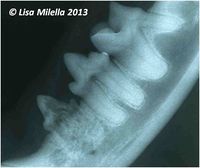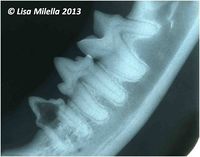Radiographic Interpretation of Tooth Resorption - Small Animal
Tooth Resorption (TR) in Cats

Radiographs of affected teeth often show root resorption that is far more advanced than expected. Every tooth with a clinical TR should be radiographically evaluated, not only to determine severity but also to determine the type of root changes that are occurring and identify concurrent pathology. Multiple teeth are often involved in affected individuals. Therefore, full mouth radiographs of all teeth may be indicated when a patient is diagnosed with TR. Some practitioners recommend full mouth radiographs of all feline patients to identify pathology that is not yet clinically apparent.
Types
Radiographs of teeth affected with TRs show distinct changes. The roots of some affected teeth seem to “disappear” as they lose radiodense root tissue at a similar rate to the simultaneously occurring osseous repair, effectively making the roots appear to blend with the surrounding bone. The Periodontal Ligament|periodontal ligament and structural details are lost. Other TRs retain areas of normal radiodensity interspersed with radiolucencies caused by resorption and do not lose the detail of the periodontal ligament space and root structures in those areas not directly undergoing resorption. Areas of root resorption are often patchy, remaining radiolucent because the lost root substance is not replaced by reparative tissue. This type of TR also commonly demonstrates concurrent periodontal or endodontic disease.
Lesions in which the roots are not replaced by bone-dense tissue are termed type 1 lesions while those in which the roots are replaced and appear to disappear are type 2 lesions. Both types of lesion can be found in the same individual cat, and even in the same tooth with one root appearing to be type 1 and the other root appearing to be a type 2. It is unknown if this is a stage of severity in which the root or region with the appearance of a type 1 lesion might eventually progress to become a type 2 lesion.
Tooth resorption in the canine teeth of cats often shows areas that appear to be combined type 1 and type 2. Over time it becomes more evident on radiographs which areas will be replaced and which are associated with pathology.
Stages
There are a number of staging systems in the literature for recording the severity or extent of lesions. Of these, the most logical and clear one categorizes TRs by severity according to objective and easily determined observation that places them into stages that may have clinical relevance.
- Stage 1 - A lesion that affects only the cementum and/or marginal enamel but does not involve the dentine. This stage occurs subgingivally where the tooth surface is exposed to cells that can become odontoclasts. It is uncommon to identify TRs at this stage. Stage 1 lesions are not radiographically apparent.
- Stage 2 - A lesion that involves the dentine but not the pulp.
- Stage 3 - A lesion that involves the pulp. Radiographs may be necessary to evaluate pulp involvement.
- Stage 4 - A lesion that has destroyed a significant amount of the crown, weakening the crown and placing it at risk of fracture even with only moderate trauma.
- Stage 5 - A lesion that has destroyed the entire crown of the tooth. The gingiva has grown over the roots and no tooth material is exposed to the oral cavity.
Radiographic evaluation allows both the type and stage of a lesion to be determined, both of which can be easily recorded on the patient’s dental chart.
Tooth Resorption in Dogs
Similar to cats and other species, dogs are affected by TRs from both known causes (most commonly periodontal or endodontic infection or inflammation) and from unproved etiology. The (currently) idiopathic TRs are far less prevalent than the feline lesions and appear very similar to the idiopathic type of TRs in cats. Type 1, type 2, and combined TRs are found in dogs, and they can be staged using the same criteria that are used to stage feline TRs.
| This article was written by Lisa Milella BVSc DipEVDC MRCVS. Date reviewed: 21 October 2014 |
| Endorsed by WALTHAM®, a leading authority in companion animal nutrition and wellbeing for over 50 years and the science institute for Mars Petcare. |
Error in widget FBRecommend: unable to write file /var/www/wikivet.net/extensions/Widgets/compiled_templates/wrt6959e0b5c76de8_83424192 Error in widget google+: unable to write file /var/www/wikivet.net/extensions/Widgets/compiled_templates/wrt6959e0b5d59999_44637319 Error in widget TwitterTweet: unable to write file /var/www/wikivet.net/extensions/Widgets/compiled_templates/wrt6959e0b5db7877_38143368
|
| WikiVet® Introduction - Help WikiVet - Report a Problem |
